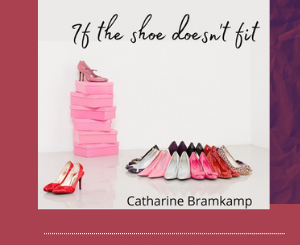To Take Up Space: Start Small by Catharine Bramkamp
 Let’s welcome back monthly columnist Catharine Bramkamp as she shares with us “To Take Up Space: Start Small.” Enjoy!
Let’s welcome back monthly columnist Catharine Bramkamp as she shares with us “To Take Up Space: Start Small.” Enjoy!
***
Forgotten Women in Art History
Jennifer Higgie in her book The Other Side, chronicles female artists who created visual works based on their spiritual experiences and beliefs, the most notably (and explosively) Hilma af Klint.
Who?
What?
When we recall art movements like — in this case — the Surrealists and Futurists, we think of Dali, Kandisky, Duchamp.
Since it was never brought up, we don’t notice the absence of women artists on these lists.
Surely some woman was painting in the early 20th century?
And they were.
Erased from the Canvas
But while these artists were painting, channeling, and expressing the inexplicable, their male counterparts were busy erasing the evidence of their work and contributions.
Both the boy’s clubs of Surrealists and Futurists flat out banned women from membership.
Even if the women artists were talented, maybe especially if they were talented, the men did not want to hear about it.
And example sited by Higgie tells the story of Janet Sobel, an untrained, 50 year old housewife who, later in life, started to paint, and paint well.
Peggy Guggenheim called Sobel “the best woman painter by far in America.”
Guggenheim championed Sobel’s work, hanging the paintings in Guggenheim’s New York gallery.
An established painter, Jackson Pollack was impressed (gobsmacked, but I wasn’t there) by Sobel’s The Milky Way.
Her painting inspired his subsequent work of action painting.
And while Pollock happily attributed Sobel’s influence, the boy’s club wasn’t having it.
Subsequent male reviewers and biographers of Pollock eliminated Sobel from the conversation, denying that Pollock could have been influenced by a mere woman who wasn’t even famous, and they should know.
Sobel herself said, “It is not easy to paint. It is very strenuous, but it’s something you’ve got to do if you have the urge.”
And that’s what she spent the second half of her life doing.
Creating Beyond the Gallery System
Artists like Pamela Colman Smith (the, up until now, unacknowledged illustrator of the Waite Tarot deck), Sobel and even af Klint refused to play the dodge ball game of art gallery promotion.
Mostly because the game took up so much time, is soul sucking and even when you win, the upkeep is painful.
For these women the point of art is celebration and exploration — expressing their spiritual connection with the universe.
As for the art gallery game, often these artists created works that thematically and literally did not fit in the available galleries.
Hilma af Klint’s work looks reasonably sized in a printed monograph, but in real life, her canvases are enormous.
She did not sell her work, and because of the size and because the works were based on spiritual visions (which by the way, did not limit the sale of male spiritually influenced work) at the time of her death, she was completely unknown.
Now we have the af Klint reproductions, the printed scarf, umbrella and mug.
Rejecting the Inner Circle
So as an artist, or poet or a musician, if you want to be a member of the inner group, you must be a de facto member of the club.
And some of us are too old to mess with that, or even take it very seriously (me).
And some of us don’t want to join a club that would accept us as a member, like Agnes Pelton who moved to the desert to paint (like O’Keefe) because she was extremely uninterested in the trappings of fame or wealth.
You are here to create, not sell, not promote (feel you).
But if you do want to grow larger, blow the roof off with your art, how can you get out into the world?
Starting Small and Growing Your Art
Let’s say you are a painter (since that’s the example we began with), and you want to increase your artistic foot print.
Ask a friend to “buy” your work.
Maybe for ten dollars (easy) or for a glass of wine (more expensive but worth it.)
That friend hangs your painting, appreciates it, and when one of THEIR friends sees the work, your friend promotes you and your work.
This promotion may lead to another sale.
One that wouldn’t support you in any material way, but the sale gets your piece out — the poem published in a small press, being paid for the band gig, accepting tips.
Maybe you donate all your artistic income.
Maybe you exchange art for manicures (which is another art, since I never know how things will turn out.)
Does this take time?
Oh hell yes, but making these small steps should satisfy and help you feel your work is moving forward gradually taking up space.
You don’t start with a gallery showing but you could lead up to one.
Or to an article in the local paper, or the third reader at a poetry slam.
I’m not saying you must share your work, that’s up to you.
What I am saying is, in the course of sharing your work, don’t stand in your own way.
And start small, begin with inviting your art-buying friend to lunch.
Share Your Art and Your Story
Has making art improved your life?
Has it influenced your health?
Does participating in art make life more fun?
Please take about five minutes to answer the survey.
Your experience and story about your art practice may be featured in the upcoming book, Take up Space (working title), tentatively scheduled for release in 2026.
Thank you!
***
Want to read more articles like this one Writer’s Fun Zone? Subscribe here.
***
ABOUT THE AUTHOR
 Catharine Bramkamp is a successful writing coach, Chief Storytelling Officer, former co-producer of Newbie Writers Podcast, and author of a dozen books including the Real Estate Diva Mysteries series, and The Future Girls series. She holds two degrees in English and is an adjunct university professor. After fracturing her wrist, she has figured out there is very little she is able to do with one hand tied behind her back. She delights in inspiring her readers.
Catharine Bramkamp is a successful writing coach, Chief Storytelling Officer, former co-producer of Newbie Writers Podcast, and author of a dozen books including the Real Estate Diva Mysteries series, and The Future Girls series. She holds two degrees in English and is an adjunct university professor. After fracturing her wrist, she has figured out there is very little she is able to do with one hand tied behind her back. She delights in inspiring her readers.






